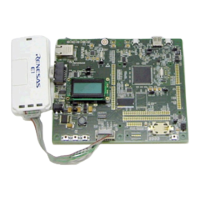R01UH0823EJ0100 Rev.1.00 Page 1062 of 1823
Jul 31, 2019
RX23W Group 33. Serial Communications Interface (SCIg, SCIh)
33.7.1 Generation of Start, Restart, and Stop Conditions
Writing 1 to the IICSTAREQ bit in the SIMR3 register causes the generation of a start condition. The generation of a
start condition proceeds through the following operations.
The level on the SSDAn line falls (from the high level to the low level) and the SSCLn line is kept in the released
state.
The hold time for the start condition is secured as half of a bit period at the bit rate determined by the setting of the
BRR.
The level on the SSCLn line falls (from the high level to the low level), the IICSTAREQ bit in the SIMR3 register
is set (to 0), and a start-condition generated interrupt is output.
Writing 1 to the IICRSTAREQ bit in the SIMR3 register causes the generation of a start condition. The generation of a
start condition proceeds through the following operations.
The SSDAn line is released and the SSCLn line is kept at the low level.
The period at low level for the SSCLn line is secured as half of a bit period at the bit rate determined by the setting
of the BRR.
The SSCLn line is released (transition from the low to the high level).
Once the high level on the SSCLn line is detected, the setup time for the restart condition is secured as half of a bit
period at the bit rate determined by the setting of the BRR.
The level on the SSDAn line falls (from the high level to the low level).
The hold time for the restart condition is secured as half of a bit period at the bit rate determined by the setting of the
BRR.
The level on the SSCLn line falls (from the high level to the low level), the IICRSTAREQ bit in the SIMR3 register
is set (to 0), and a restart-condition generated interrupt is output.
Writing 1 to the IICSTPREQ bit in the SIMR3 register causes the generation of a stop condition. The generation of a stop
condition proceeds through the following operations.
The level on the SSDAn line falls (from the high level to the low level) and the SSCLn line is kept at the low level.
The period at low level for the SSCLn line is secured as half of a bit period at the bit rate determined by the setting
of the BRR.
The SSCLn line is released (transition from the low to the high level).
Once the high level on the SSCLn line is detected, the setup time for the stop condition is secured as half of a bit
period at the bit rate determined by the setting of the BRR.
The SSDAn is released (transition from
the low to the high level), the IICSTPREQ bit in the SIMR3 register is set
(to 0), and a stop-condition generated interrupt is output.

